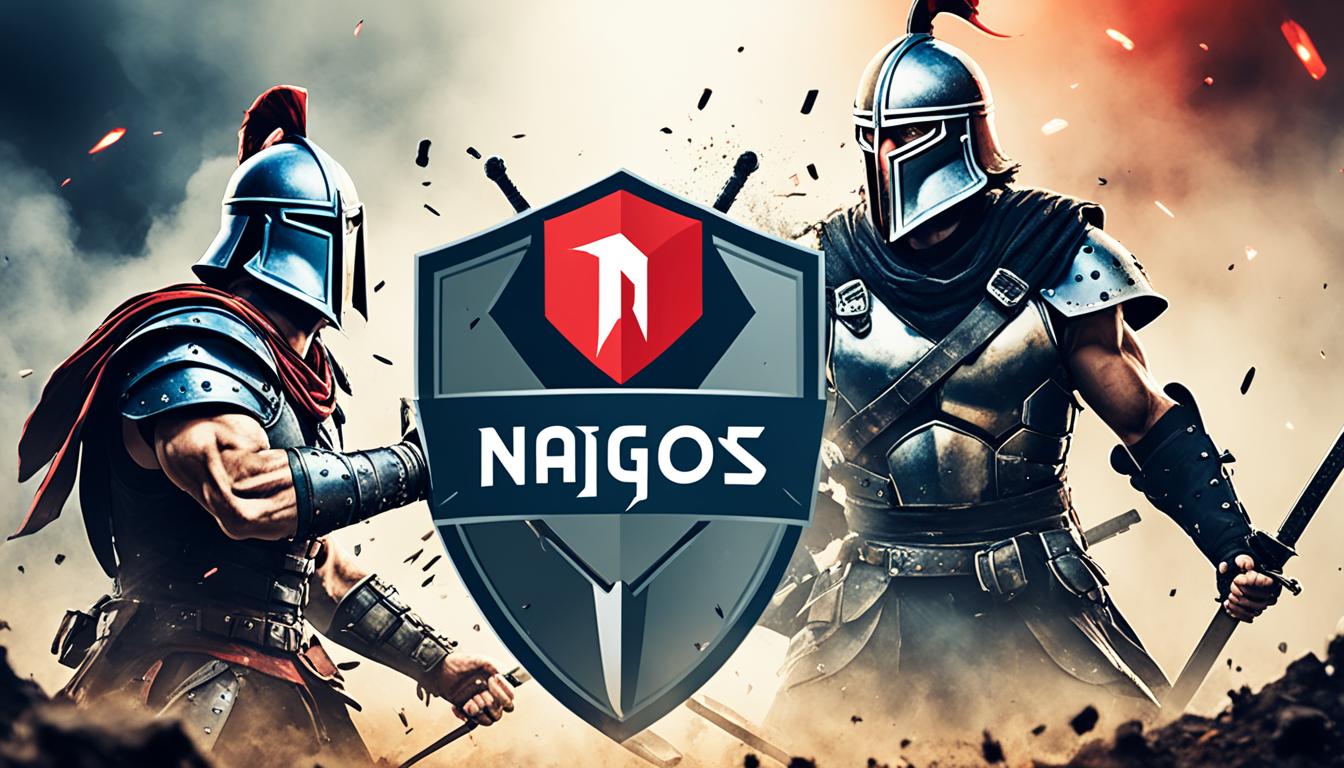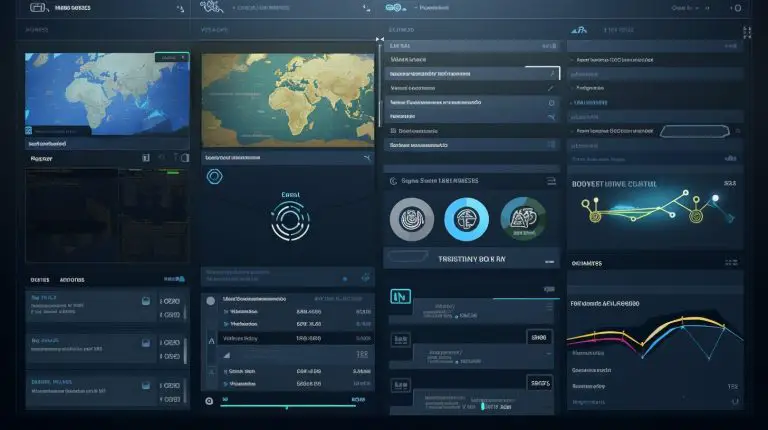Nagios vs. Zabbix: Which Monitoring Tool Wins?
When it comes to network monitoring tools, Nagios and Zabbix are two popular choices that often come up in discussions. Both are open-source, enterprise-grade solutions with a wide array of features and capabilities. But which one is better? Which monitoring tool will give you the performance, scalability, and ease of use you need for your network infrastructure?
Let’s dive deep into the strengths and functionalities of Nagios and Zabbix to determine which tool reigns supreme. From installation and deployment to metrics collection, architecture, and more, we will compare these tools head-to-head to see which one comes out on top.
So, which monitoring tool takes the crown? Is Nagios the go-to solution for your network monitoring needs, or should you choose Zabbix for its robust features? Let’s explore and find out the answer!
Key Takeaways:
- Nagios and Zabbix are two popular network monitoring tools that are often compared in terms of features, performance, and ease of use.
- In this article, we will compare Nagios and Zabbix in various aspects such as installation and deployment, metrics collection, architecture, compatible platforms, scalability, data visualization, incident management and alerting, UI & UX design, documentation and support, and pricing.
- By the end of this article, you will have a clear understanding of which monitoring tool is better suited for your network infrastructure.
- Nagios and Zabbix are both open-source, enterprise-grade solutions that offer powerful monitoring capabilities.
- Stay tuned to discover the strengths and weaknesses of each tool and make an informed decision for your network monitoring needs.
Overview of Nagios, Zabbix, and Prometheus
Nagios, Zabbix, and Prometheus are powerful and popular infrastructure monitoring solutions that provide comprehensive monitoring capabilities for servers, networks, cloud services, and more. Each tool offers unique functionalities and features that cater to different monitoring needs.
Nagios Core
Nagios Core is a free and open-source monitoring application that allows users to monitor servers and services in real-time. With its easy installation process and user-friendly interface, Nagios Core is a reliable choice for IT professionals. It provides alerts and notifications when issues arise, ensuring timely intervention and resolution.
Zabbix
Zabbix is another open-source monitoring solution specifically designed for monitoring IT infrastructures. It offers a wide range of functionalities, including monitoring of network devices, servers, virtual machines, and cloud services. Zabbix’s easy installation process and intuitive user interface make it a popular choice among IT administrators.
Prometheus
Prometheus is a server monitoring tool that specializes in collecting time series data from servers and compiling them into detailed graphs and charts. It offers a robust querying language called PromQL, which allows users to retrieve and aggregate time-series data efficiently. Prometheus provides an extensive set of metrics for monitoring a wide range of systems and services.
Overall, Nagios, Zabbix, and Prometheus are all capable infrastructure monitoring solutions, each with its own unique set of features and functionalities. Deciding which tool is best for your specific needs requires careful consideration of factors such as easy installation, metrics collection, architecture, platform compatibility, scalability, data visualization, incident management, UI & UX design, documentation, and pricing.
Next, we will take a closer look at the installation and deployment process of these tools to understand their ease of use and setup.
Installation and Deployment: Prometheus > Nagios > Zabbix
When it comes to installation and deployment, ease and efficiency are crucial factors to consider. Prometheus takes the lead in this category, offering a hassle-free installation process that requires minimal effort and time. Users can quickly set up Prometheus without the need for external data storage, streamlining the deployment experience.
Nagios Core, on the other hand, provides a step-by-step installation guide to help users navigate through the setup process. However, it does require additional installations and configurations, which may take longer and require more technical know-how.
Zabbix also offers an installation guide for users, but it falls short in providing detailed instructions for setting up the required database and web server. This lack of guidance can present challenges for those with limited technical expertise.
Step-by-Step Installation Guide for Nagios Core:
- Download the Nagios Core installation package from the official website.
- Follow the provided instructions to install the necessary dependencies and prerequisites, ensuring compatibility with your operating system.
- Configure the Apache server to host Nagios and enable necessary modules.
- Download and install the Nagios Plugins, which provide additional functionalities for monitoring various services.
- Configure Nagios Core by editing the necessary configuration files, setting up hosts, services, and notification settings.
- Test the configuration and start the Nagios Core service.
- Access the Nagios Core web interface and customize the dashboard and monitoring settings according to your requirements.
Summary of the Installation Process:
| Tool | Installation Difficulty | External Data Storage Requirement |
|---|---|---|
| Prometheus | Easy | No |
| Nagios Core | Moderate | No |
| Zabbix | Moderate | Requires setting up the database and web server |
Metrics Collection: Prometheus > Zabbix > Nagios
Effective metrics collection is vital for monitoring the performance and health of your infrastructure. When it comes to this aspect, Prometheus stands out as the frontrunner, offering a range of powerful functionalities to collect and analyze metrics. Using PromQL, a unique query language, Prometheus retrieves and aggregates time-series data from a multidimensional data model, providing in-depth insights into your system’s behavior and performance.
On the other hand, Zabbix employs an item key format for metrics collection. This approach allows for customization of the collected data, granting more flexibility in defining the metrics that matter most to your organization. While Zabbix doesn’t match the raw power of Prometheus, it still provides a robust solution for gathering and examining crucial metrics.
Meanwhile, Nagios takes a different approach, relying on plugins for monitoring various services. This plugin-based system enables Nagios to monitor a wide range of services but lacks the customization options offered by Prometheus and Zabbix. If you have specific monitoring requirements, Nagios might require additional plugins to address them adequately.
Metrics Collection Comparison:
| Metric Collection Tool | Approach | Customization Options |
|---|---|---|
| Prometheus | PromQL-based queries on a multidimensional data model | Limited customization options |
| Zabbix | Item key format | Greater customization options |
| Nagios | Plugin-based system | Limited customization options, additional plugins may be required |
As the table illustrates, Prometheus offers a comprehensive and versatile solution for metrics collection due to its powerful query language and multidimensional data model. Zabbix provides a good balance between customization and ease of use with its item key format. Nagios, while capable of monitoring many services, requires the use of plugins and lacks the same level of customization options as its counterparts.
In conclusion, if robust metrics collection capabilities are your top priority, Prometheus is the clear winner. However, both Zabbix and Nagios bring their own strengths to the table, whether it’s customization or broad service monitoring compatibility. Consider your specific monitoring requirements and choose the solution that aligns best with your organization’s needs.
Architecture: Nagios = Zabbix = Prometheus
Nagios, Zabbix, and Prometheus each have their own unique architecture approaches, while all incorporating a host-agent architecture or a similar framework for monitoring network systems. These three monitoring tools have different considerations when it comes to their architectural setups.
Nagios Architecture
Nagios utilizes a host-agent architecture, where the Nagios server acts as the central control hub, and agents are installed on target systems to collect necessary data. Nagios provides a modular architecture that allows users to extend its functionality through various plugins. These plugins are used to monitor different aspects of the system, such as network devices, services, and applications. However, this architecture can be slightly complex due to the need for plugins to monitor specific components.
Zabbix Architecture
Like Nagios, Zabbix also follows a host-agent architecture model. The Zabbix server acts as the central point of control, while agents are installed on monitored systems. Zabbix supports a wide range of monitoring capabilities, including network, server, and application monitoring. Similar to Nagios, Zabbix also relies on plugins to extend its capabilities. This flexibility allows users to customize their monitoring setup based on their specific needs.
Prometheus Architecture
Prometheus takes a different approach to architecture compared to Nagios and Zabbix. It follows a server-based model where the Prometheus server directly collects metrics from monitored targets using a pull-based approach. This eliminates the need for agents to be installed on target systems. Prometheus has a simpler architecture by design, making it easier to configure data collection and storage. It also eliminates the dependency on external data storage systems, as it comes with its own time-series database.
The architecture comparison between Nagios, Zabbix, and Prometheus highlights the different considerations when choosing a monitoring tool. Nagios and Zabbix’s use of plugins offers greater flexibility in monitoring various components but can introduce some complexity. On the other hand, Prometheus’s simpler architecture allows for easier configuration and eliminates the need for external data storage. Ultimately, the choice of architecture depends on the specific requirements and preferences of the organization or user.
Compatible Platforms: Prometheus > Zabbix/Nagios
When it comes to compatible platforms, each monitoring tool has its own strengths and limitations.
Nagios is primarily designed to run on Linux operating systems, making it a popular choice for Linux monitoring. However, with the right plugins, Nagios can also monitor Windows and Unix operating systems, providing cross-platform monitoring capabilities.
Zabbix, on the other hand, has specific requirements for the operating system version and distribution. It can run on Linux, macOS, and Windows, offering monitoring capabilities for a wide range of platforms. This flexibility makes Zabbix a suitable choice for businesses operating on diverse environments.
Prometheus also offers compatibility with Linux, macOS, and Windows operating systems, making it a versatile option for monitoring mixed-platform infrastructures. Whether you are using Linux, macOS, or Windows, Prometheus can efficiently monitor your systems and provide valuable insights.
Platform Compatibility Comparison
| Monitoring Tool | Compatible Platforms |
|---|---|
| Nagios | Linux, Windows, Unix |
| Zabbix | Linux, macOS, Windows |
| Prometheus | Linux, macOS, Windows |
As seen in the table above, all three monitoring tools offer compatibility with Linux. However, Zabbix and Prometheus have broader platform support, including macOS and Windows. This compatibility allows businesses to monitor their IT infrastructure regardless of the operating system they use, ensuring comprehensive monitoring capabilities across multiple platforms.
Scalability: Prometheus/Zabbix > Nagios
In order to meet the demands of a constantly growing IT infrastructure, it is crucial for monitoring tools to offer scalable solutions. While all three tools – Nagios, Zabbix, and Prometheus – can be scaled, there are some differences in the process.
When it comes to Nagios and Zabbix, scalability requires additional configurations and installations. Nagios, for instance, may require the use of multiple servers to handle larger infrastructure demands effectively. On the other hand, Zabbix has a workaround called Zabbix proxy that helps reduce the load on the main server, enabling better scalability.
Prometheus, however, takes a different approach to scaling. It offers a tool called Federation, which allows users to retrieve and aggregate data from other Prometheus servers. This feature makes Prometheus a highly scalable option for handling the increasing needs of IT infrastructure monitoring.
Considering the scalability aspect, it is evident that Prometheus and Zabbix have an advantage over Nagios. While Nagios and Zabbix require additional configurations and installations, Prometheus provides a more seamless scaling experience with its Federation feature.
To summarize:
- Nagios requires additional servers for scalability.
- Zabbix offers a workaround – Zabbix proxy – to reduce the load on the main server.
- Prometheus has the Federation feature for retrieving and aggregating data from other Prometheus servers.
If you’re looking for a monitoring tool that can effortlessly scale to meet your IT infrastructure demands, both Prometheus and Zabbix are excellent choices.

Data Visualization: Zabbix > Prometheus/Nagios
Zabbix surpasses Nagios and Prometheus in the realm of data visualization. While Nagios requires the utilization of a plugin known as NagVis to create visualizations, Zabbix comes equipped with built-in capabilities for generating charts and dashboards. With Zabbix, users have the ability to create custom charts, aggregate data from multiple sources, and even construct comprehensive network maps. On the other hand, Prometheus lacks advanced visualization capabilities, only allowing users to view one graph at a time.
Now, let’s take a closer look at the data visualization features offered by Zabbix:
- NagVis Plugin: Nagios requires the use of the NagVis plugin to create visual representations of data. This plugin extends the capabilities of Nagios and allows for the creation of custom maps and diagrams.
- Custom Charts: Zabbix provides a user-friendly interface for creating customized charts and graphs. Users can easily select the metrics they want to visualize, apply various graph types, and customize the appearance of the charts.
- Network Maps: Zabbix allows users to create network maps that provide a visual representation of the infrastructure. These maps can display the status of network devices, the connections between them, and other relevant information.
- Expression Browser: Zabbix offers an expression browser that allows users to explore and analyze complex formulas and expressions used for data collection and visualization. This feature provides advanced users with granular control over their visualizations.
With Zabbix’s robust data visualization capabilities, users can easily gain valuable insights from their monitoring data and effectively communicate important information to stakeholders.
| Detailed Comparison of Data Visualization Features | Zabbix | Prometheus | Nagios |
|---|---|---|---|
| Built-in Visualization Capabilities | Yes | No | No |
| Custom Chart Creation | Yes | No | No |
| Network Map Creation | Yes | No | No |
| Expression Browser | Yes | No | No |
Incident Management and Alerting: Zabbix > Prometheus > Nagios
When it comes to incident management and alerting, Zabbix takes the lead among the three monitoring tools. It offers a comprehensive set of features and functionalities to ensure efficient handling of incidents. Zabbix provides a graphical interface that simplifies the process of defining notification methods, custom scripts, and setting up threshold-based conditions for triggering alerts.
Prometheus, on the other hand, requires the installation of Alertmanager to manage the creation of alert rules and notifications. While it offers flexibility and customization options, the setup process can be more complex compared to Zabbix.
In contrast, Nagios lacks a graphical interface for incident management and relies on manual configuration of alert rules in text files. This can be time-consuming and prone to errors, especially in larger environments with numerous alert rules.
Mechanisms for Handling Incidents
When it comes to handling incidents, Zabbix provides an extensive range of options. It allows users to define notification methods, such as email, SMS, or custom scripts, to ensure that the right people are promptly alerted when issues arise. Zabbix also supports multiple notification channels simultaneously, enabling efficient communication to restore services quickly.
Furthermore, Zabbix offers an escalation mechanism that allows the definition of multiple alerting stages. This ensures that if an incident remains unresolved after a certain period or if it escalates in severity, notifications can be escalated to higher-level teams or personnel with appropriate expertise.
Prometheus, when combined with Alertmanager, provides similar incident management capabilities. It allows users to define alert rules based on certain conditions and send notifications through various channels. However, the configuration process may require additional technical expertise compared to Zabbix’s user-friendly graphical interface.
“Zabbix’s comprehensive incident management and alerting functionalities, along with its intuitive graphical interface, make it an excellent choice for organizations looking for robust and efficient incident response capabilities.”
Comparing Incident Management Capabilities
| Tool | Graphical Interface | Notification Methods | Escalation Mechanism |
|---|---|---|---|
| Zabbix | Yes | Extensive options, including email, SMS, custom scripts | Supports advanced escalation stages |
| Prometheus | Requires Alertmanager | Flexible notification channels | Allows escalation of alerts |
| Nagios | No | Manual configuration in text files | N/A |
Overall, Zabbix excels in incident management and alerting capabilities, providing both advanced functionality and ease of use. Its graphical interface, rich notification methods, and flexible escalation mechanism enable organizations to effectively manage incidents and minimize downtime. Prometheus, while offering similar features, requires additional setup and configuration, making it more suitable for users with more technical expertise. Nagios lags behind in this aspect, lacking a graphical interface and requiring manual configuration of alert rules.
Conclusion
After closely comparing Nagios and Zabbix, it is clear that Zabbix provides a more robust and feature-rich solution for network monitoring. With its superior user interface, easier configuration, better data visualization, and comprehensive incident management and alerting capabilities, Zabbix emerges as the winner in this comparison.
Although Nagios and Prometheus have their strengths, Zabbix stands out as an open-source, enterprise-grade monitoring tool that offers advanced features and exceptional performance. Its strong community support ensures continuous improvement and reliable assistance for users.
For businesses and organizations seeking a powerful and scalable network monitoring solution, Zabbix is the ideal choice. Its extensive range of features, reliable performance, and easy-to-use interface make it a preferred option for both small and large-scale environments.
FAQ
What is Nagios?
What is Zabbix?
What is Prometheus?
Which tool is the easiest to install and deploy?
How do these tools collect metrics?
What is the architecture of these tools?
Which operating systems are compatible with these tools?
How scalable are these tools?
Which tool has the best data visualization capabilities?
Which tool has the most comprehensive incident management and alerting features?
Which tool is the overall winner in this comparison?
Source Links
- https://betterstack.com/community/comparisons/nagios-vs-zabbix-vs-prometheus/
- https://www.comparitech.com/net-admin/nagios-vs-zabbix/
- https://www.letscloud.io/blog/nagios_vs_zabbix/
- About the Author
- Latest Posts
Janina is a technical editor at Text-Center.com and loves to write about computer technology and latest trends in information technology. She also works for Biteno.com.





